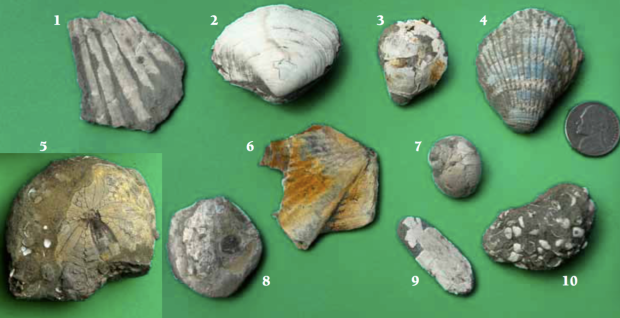Directions:
“Approach the bluffs from an access point on the southeast side of the Rio Dell/Scotia bridge. Walk along the railroad tracks (abandoned) under Highway 101 to the Bluffs. There is no automobile access beyond the parking lot that belongs to Pacific Lumber. Check in with their guard. If you’re lucky, it’s the gentleman who knows more about the local fossils than just about anyone else in Humboldt. Park your car with him or his coworkers.
Be sure to take a knapsack or backpack as this is a hike out to the bluffs. Walk along the tracks until you can see the railroad bridge. This is where the big pelecypod mollusks (look like the Shell Oil insignia) are found in mudstone or eroding out. they can be up to about 9 inches across if complete.
Cross the railroad bridge with caution to an exposure of sandstone or sand. This is the area which produces sand dollars and concretions which contain mollusks and other fossils.” (from Fossil Localities, cited below).
Geology of the Area:
The Scotia Bluffs sandstone was deposited around two million years ago during the Pleistocene epoch. The fine to medium grained sediment has a maximum thickness of 640 m. It is part of the Upper Wildcat group and overlies the Rio Dell Formation in Humboldt County. Additionally, the cliffs are about 15 miles from the coast and are at an elevation of 550 feet.
Paleontology of the Area:
Shallow fossil marine life from the Pleistocene epoch can be found in the bluffs, with many of the species still thriving today. According to “Unearthing Evidence of Creatures from Deep Time” by Leslie Scopes Anderson, Giant Pacific Scallop (Petinopecten sp.), Clam (Thrasia sp.), Cockle Shell (Clinocardium meekianum), Sand Dollar (Scutellaster sp.), Moon Snail (Nautica clause), Pandora shell (Pandora sp.), Razor Clam (Siliqua oregonensa) and Shelly sandstone (Psephidia sp.) have been recovered from the area. See image below.

Other Fossil Sites Nearby:
Other fossil hunting sites nearby include Centerville Beach and Elk Head.
Works Cited:
Hugh McLean, “Federal Lands Assessment Program: Eel River (Humboldt) Basin, California (Province 80),” (USGS 1988) <http://pubs.usgs.gov/of/1987/0450i/report.pdf>
Leslie Scopes Anderson, “Unearthing Evidence of Creatures from Deep Time,” (Humboldt U 2011) www2.humboldt.edu
“Fossil Localities”, http://ebeltz.net/fieldtrips/humfossils.html

